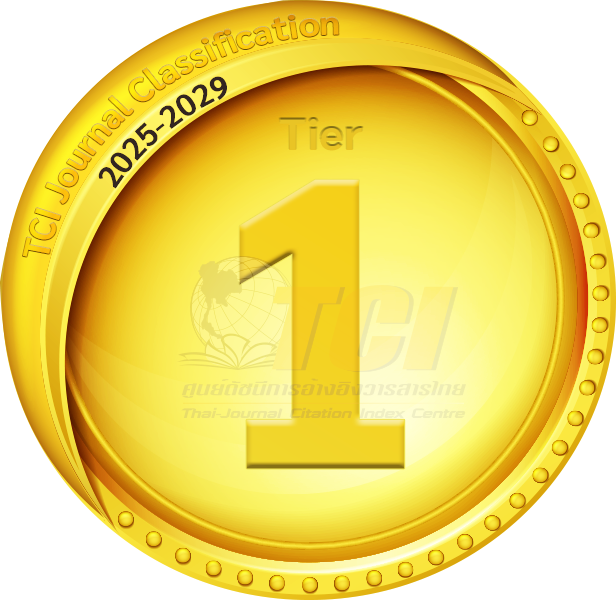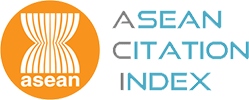Comparative Study on Techno-Economic Analysis for Various Organosolv Fractionation of Bagasse in Thailand
Abstract
Keywords
[1] EPPO, “Energy Statistics of Thailand 2023,” EPPO, Bangkok, Thailand, 2024.
[2] Preethi, M. Gunasekaran, G. Kumar, O. P. Karthikeyan, S. Varjani, and B. J. Rajesh, “Lignocellulosic biomass as an optimistic feedstock for the production of biofuels as valuable energy source: Techno-economic analysis, environmental impact analysis, breakthrough and perspectives,” Environmental Technology & Innovation, vol. 24, 2021, Art. no. 102080, doi: 10.1016/j.eti.2021.102080.
[3] M. Jayakumar, G. T. Gindaba, K. B. Gebeyehu, S. Periyasamy, A. Jabesa, G. Baskar, B. I. John, and A. Pugazhendhi, “Bioethanol production from agricultural residues as lignocellulosic biomass feedstocks waste valorization approach: A comprehensive review,” Science of The Total Environment, vol. 879, 2023, Art. no. 163158, doi: 10.1016/j.scitotenv.2023.163158.
[4] DEDE, “Alternative Energy Development Plan: AEDP2015 (B.E. 2558–2579): Ministry of Energy, 2015, Bangkok, Thailand, 2024.
[5] A. Devi, S. Bajar, H. Kour, R. Kothari, D. Pant, and A. Singh, “Lignocellulosic biomass valorization for bioethanol production: A circular bioeconomy approach,” Bioenergy Research, vol. 15, no. 4, pp. 1820–1841, 2022, doi: 10.1007/s12155-022-10401-9.
[6] N. Raina, S. Sharma, A. K. Sharma, R. Rana, V. Sharma, and M. Kumar, “Process performance evaluation of different chemical pretreatments of lignocellulosic biomass for bioethanol production,” Industrial Crops and Products, vol. 211, 2024, Art. no. 118207, doi: 10.1016/ j.indcrop.2024.118207.
[7] A. M. Joseph, Y. Tulasi, D. Shrivastava, and B. Kiran, “Techno-economic feasibility and exergy analysis of bioethanol production from waste,” Energy Conversion and Management: X, vol. 18, 2023, Art. no. 100358, doi: 10.1016/j.ecmx. 2023.100358.
[8] H. A. Ruiz, W. G. Sganzerla, V. Larnaudie, R. J. Veersma, G. van Erven, S. Rios-Gonzalez, R. M. Rodriguez-Jasso, G. Rosero-Chasoy, M. D. Ferrari, M. A. Kabel, T. Forster-Carneiro, and C. Lareo, “Advances in process design, techno-economic assessment and environmental aspects for hydrothermal pretreatment in the fractionation of biomass under biorefinery concept,” Bioresource Technology, vol. 369, 2023, Art. no. 128469, doi: 10.1016/j.biortech. 2022.128469.
[9] K. Weerasai, N. Laosiripojana, S. Imman, T. Kreetachat, and N. Suriyachai, “Reusable alkaline catalyzed organosolv pretreatment and delignification of bagasse for sugar platform biorefinery,” Biomass Conversion and Biorefinery, vol. 13, 2023, pp. 1751–1761, doi: 10.1007/s13399-020-01269-w.
[10] N. Suriyachai, V. Champreda, N. Kraikul, W. Techanan, and N. Laosiripojana, “Fractionation of lignocellulosic biopolymers from sugarcane bagasse using formic acid-catalyzed organosolv process,” 3 Biotech, vol. 8, 2018, Art. no. 221, doi: 10.1007/s13205-018-1244-9.
[11] E. J. Panakkal, M. Sriariyanun, J. Ratanapoompinyo, P. Yasurin, K. Cheenkachorn, W. Rodiahwati, and P. Tantayotai, “Influence of sulfuric acid pretreatment and inhibitor of sugarcane bagasse on the production of fermentable sugar and ethanol,” Applied Science and Engineering Progress, vol. 15, 2022, Art. no. 5238, doi: 10.14416/j.asep.2021.07.006.
[12] S. Gutierrez, F. Mangone, P. Vergara, V. Gonzalez, J. P. Ferreira, J. C. Villar, and F. Garcia-Ochoa, “Lignocellulosic biomass pre-treatments by diluted sulfuric acid and ethanol-water mixture: A comparative techno-economic analysis,” Bioresource Technology Reports, vol. 23, 2023, Art. no. 101514, doi: 10.1016/j.biteb. 2023.101514.
[13] B. Liu, L. Liu, B. Deng, C. Huang, J. Zhu, L. Liang, X. He, Y. Wei, C. Qin, C. Liang, S. Liu, and S. Yao, “Application and prospect of organic acid pretreatment in lignocellulosic biomass separation: A review,” International Journal of Biological Macromolecules, vol. 222, pp. 1400–1413, 2022, doi: 10.1016/j.ijbiomac.2022.09.270.
[14] N. R. Baral and A. Shah, “Comparative techno-economic analysis of steam explosion, dilute sulfuric acid, ammonia fiber explosion and biological pretreatments of corn stover,” Bioresource Technology, vol. 232, pp. 331–343, 2017, doi: 10.1016/j.biortech.2017.02.068.
[15] A. R. Gurgel da Silva, A. Giuliano, M. Errico, B.-G. Rong, and D. Barletta, “Economic value and environmental impact analysis of lignocellulosic ethanol production: Assessment of different pretreatment processes,” Clean Technologies and Environmental Policy, vol. 21, pp. 637–654, 2019, doi: 10.1007/s10098-018-01663-z.
[16] S. Areeya, E. J. Panakkal, M. Sriariyanun, T. Kangsadan, A. Tawai, S. Amornraksa, U. W. Hartley, and P. Yasurin, “A review on chemical pretreatment of lignocellulosic biomass for the production of bioproducts: Mechanisms, challenges and applications,” Applied Science and Engineering Progress, vol. 16, 2023, Art. no. 6767, doi: 10.14416/j.asep.2023.02.008.
[17] R. Fu, L. Kang, C. Zhang, and Q. Fei, “Application and progress of techno-economic analysis and life cycle assessment in biomanufacturing of fuels and chemicals,” Green Chemical Engineering, vol. 4, no. 2, pp. 189–198, 2023, doi: 10.1016/j.gce.2022.09.002.
[18] M. Abdou Alio, A. Marcati, A. Pons, and C. Vial, “Modeling and simulation of a sawdust mixture-based integrated biorefinery plant producing bioethanol,” Bioresource Technology, vol. 325, 2021, Art. no. 124650, doi: 10.1016/j.biortech. 2020.124650.
[19] F. Bisotti, M. Gilardi, O. T. Berglihn, R. Tschentscher, L. D. Hansen, S. J. Horn, A. Várnai, and B. Wittgens, “From laboratory scale to innovative spruce-based biorefinery. Note I: Conceptual process design and simulation,” Computer Aided Chemical Engineering, vol. 53, pp. 2449–2454, 2024, doi: 10.1016/B978-0-443-28824-1.50409-9.
[20] J. C. Solarte-Toro, C. A. Rueda-Duran, M. Ortiz-Sanchez, and C. A. C. Alzate, “A comprehensive review on the economic assessment of biorefineries: The first step towards sustainable biomass conversion,” Bioresource Technology Reports, vol. 15, 2021, Art. no. 100776, doi: 10.1016/j.biteb.2021.100776.
[21] T. Y. Chong, S. A. Cheah, C. T. Ong, L. Y. Wong, C. R. Goh, I. S. Tan, H. C. Y. Foo, M. K. Lam, and S. Lim, “Techno-economic evaluation of third-generation bioethanol production utilizing the macroalgae waste: A case study in Malaysia,” Energy, vol. 210, 2020, Art. no. 118491, doi: 10.1016/j.energy.2020.118491.
[22] T. Y. Chong, S. A. Cheah, C. T. Ong, L. Y. Wong, C. R. Goh, I. S. Tan, H. C. Y. Foo, M. K. Lam, and S. Lim, “Techno-economic evaluation of third-generation bioethanol production utilizing the macroalgae waste: A case study in Malaysia,” Energy, vol. 210, 2020, Art. no. 118491, doi: 10.1016/j.energy.2020.118491.
[23] H. Chen, D. Zhou, G. Luo, S. Zhang, and J. Chen, “Macroalgae for biofuels production: Progress and perspectives,” Bioresource Technology, vol. 320, 2021, Art. no. 124533, doi: 10.1016/j.biortech.2021.124533.
[24] L. Ansaloni, D. Fabbri, and G. Spigno, “Valorization of macroalgal biomass for the production of renewable chemicals: A review,” Industrial Crops and Products, vol. 159, 2021, Art. no. 113051, doi: 10.1016/j.indcrop.2020. 113051.
[25] D. Humbird, R. Davis, L. Tao, C. Kinchin, D. Hsu, A. Aden, P. Schoen, J. Lukas, B. Olthof, M. Worley, D. Sexton, and D. Dudgeon, “Process design and economics for biochemical conversion of lignocellulosic biomass to ethanol: Dilute-acid pretreatment and enzymatic hydrolysis of corn stover,” National Renewable Energy Laboratory, NREL/TP-5100-47764, 2011, doi: 10.2172/1013269.
[26] H. W. Oh, S. C. Lee, H. C. Woo, and Y. H. Kim, “Energy-efficient recovery of fermented butyric acid using octyl acetate extraction,” Biotechnology for Biofuels and Bioproducts, vol. 15, no. 1, 2022, Art. no. 46, doi: 10.1186/s13068-022-02146-6.
[27] J. Viell, A. Harwardt, J. Seiler, and W. Marquardt, “Is biomass fractionation by Organosolv-like processes economically viable? A conceptual design study,” Bioresource Technology, vol. 150, pp. 89–97, 2013, doi: 10.1016/j.biortech.2013.09.078.
[28] A. R. G. da Silva, M. Errico, and B.-G. Rong, “Solvent recycle and impurity purge evaluation for organosolv pretreatment method for bioethanol production from lignocellulosic biomass,” Computer Aided Chemical Engineering, vol. 40, pp. 1141–1146, 2017, doi: 10.1016/ B978-0-444-63965-3.50192-6.
[29] G. Towler and R. Sinnott, Chemical Engineering Design: Principles, Practice and Economics of Plant and Process Design, 3rd ed. Oxford, UK: Butterworth-Heinemann, 2021.
[30] P. Peerapong, “Renewable energy strategies for sustainable development in Thailand,” Ph.D. dissertation, Sirindhorn International Institute of Technology, Thammasat University, Pathum Thani, Thailand, 2019.
[31] Echemi. “Weekly chemical prices.” Echemi.com. https://www.echemi.com/weekly-price (accessed Mar. 26, 2025).
[32] P. W. Authority. “Provincial Waterworks Authority website.” PWA.co.th. https://www. pwa.co.th (accessed Mar. 26, 2024).
[33] E. G. A. of Thailand. “EGAT Price.” EGAT.co.th. https://www.egat.co.th/home/egat-price (accessed Mar. 26, 2024).
[34] K. L. Lim, W. Y. Wong, N. J. Rubinsin, S. K. Loh, and M. T. Lim, “Techno-economic analysis of an integrated bio-refinery for the production of biofuels and value-added chemicals from oil palm empty fruit bunches,” Processes, vol. 10, no. 10, 2022, Art. no. 1965, doi: 10.3390/pr 10101965.
[35] R. H. Hafyan, J. M. Miskolczi, M. U. Uddin, V. K. Kamarudin, V. N. Nguyen, and S. K. Mohapatra, “Integrated biorefinery for bioethanol and succinic acid co-production from bread waste: Techno-economic feasibility and life cycle assessment,” Energy Conversion and Management, vol. 301, 2024, Art. no. 118033, doi: 10.1016/j.enconman.2023.118033.
[36] S. S. Wirawan, M. D. Solikhah, P. T. Widiyanti, N. P. D. Nitamiwati, R. Romelan, Y. Heryana, A. Nurhasanah, and A. Sugiyono, “Unlocking Indonesia's sweet sorghum potential: A techno-economic analysis of small-scale integrated sorghum-based fuel grade bioethanol industry,” Bioresource Technology Reports, vol. 25, 2024, Art. no. 101706, doi: 10.1016/j.biteb.2023.101706.
[37] L. G. Nair, K. Agrawal, and P. Verma, “Organosolv pretreatment: An in-depth purview of mechanics of the system,” Bioresources and Bioprocessing, vol. 10, no. 1, 2023, Art. no. 50, doi: 10.1186/s40643-023-00673-0.
[38] M.-H. Cheng, Z. Wang, B. S. Dien, P. J. W. Slininger, and V. Singh, “Economic analysis of cellulosic ethanol production from sugarcane bagasse using a sequential deacetylation, hot water and disk-refining pretreatment,” Processes, vol. 7, no. 10, 2019, Art. no. 642, doi: 10.3390/pr7100642.
[39] W. G. Sganzerla, D. Lachos-Perez, L. S. Buller, G. L. Zabot, and T. Forster-Carneiro, “Cost analysis of subcritical water pretreatment of sugarcane straw and bagasse for second-generation bioethanol production: A case study in a sugarcane mill,” Biofuels, Bioproducts and Biorefining, vol. 16, no. 2, pp. 435–450, 2022, doi: 10.1002/bbb.2332.
[40] J. M. Romero-García, J. C. Solarte-Toro, Á. Galán-Martín, E. Ruiz, E. Castro, M. Ortiz-Sánchez, and C. A. Cardona Alzate, “Olive leaves upgrading applying a novel two-stage organosolv pretreatment: Techno-economic and environmental assessment,” Biochemical Engineering Journal, vol. 207, 2024, Art. no. 109317, doi: 10.1016/j.bej.2024.109317.
[41] J. Peng, H. Xu, W. Wang, Y. Kong, Z. Su, and B. Li, “Techno-economic analysis of bioethanol preparation process via deep eutectic solvent pretreatment,” Industrial Crops and Products, vol. 172, 2021, Art. no. 114036, doi: 10.1016/j.indcrop.2021.114036.
[42] R. Turton, J. A. Shaeiwitz, D. Bhattacharyya, and W. B. Whiting, Analysis, Synthesis, and Design of Chemical Processes. Hoboken, NJ: Pearson Education, 2018.
[43] M. M. Parascanu, N. Sanchez, F. Sandoval-Salas, C. M. Carreto, G. Soreanu, and L. Sanchez-Silva, “Environmental and economic analysis of bioethanol production from sugarcane molasses and agave juice,” Environmental Science and Pollution Research, vol. 28, no. 45, pp. 64374–64393, 2021, doi: 10.1007/s11356-021-15471-4.
[44] S. Gadkari, V. Narisetty, S. K. Maity, H. G. Manyar, K. Mohanty, R. B. Jeyakumar, K. K. Pant, and V. Kumar, “Techno-economic analysis of 2,3-butanediol production from sugarcane bagasse,” ACS Sustainable Chemistry & Engineering, vol. 11, no. 22, pp. 8337–8349, 2023, doi: 10.1021/acssuschemeng.3c01221.
[45] K. Morris-Schaffer and M. J. McCoy, “A review of the LD₅₀ and its current role in hazard communication,” ACS Chemical Health & Safety, vol. 28, no. 1, pp. 25–33, 2021, doi: 10.1021/acs.chas.0c00096.
[46] World Health Organization, The WHO recommended Classification of Pesticides by Hazard and Guidelines to Classification. Geneva, Switzerland: World Health Organization, 2019.DOI: 10.14416/j.asep.2025.06.011
Refbacks
- There are currently no refbacks.
 Applied Science and Engineering Progress
Applied Science and Engineering Progress







